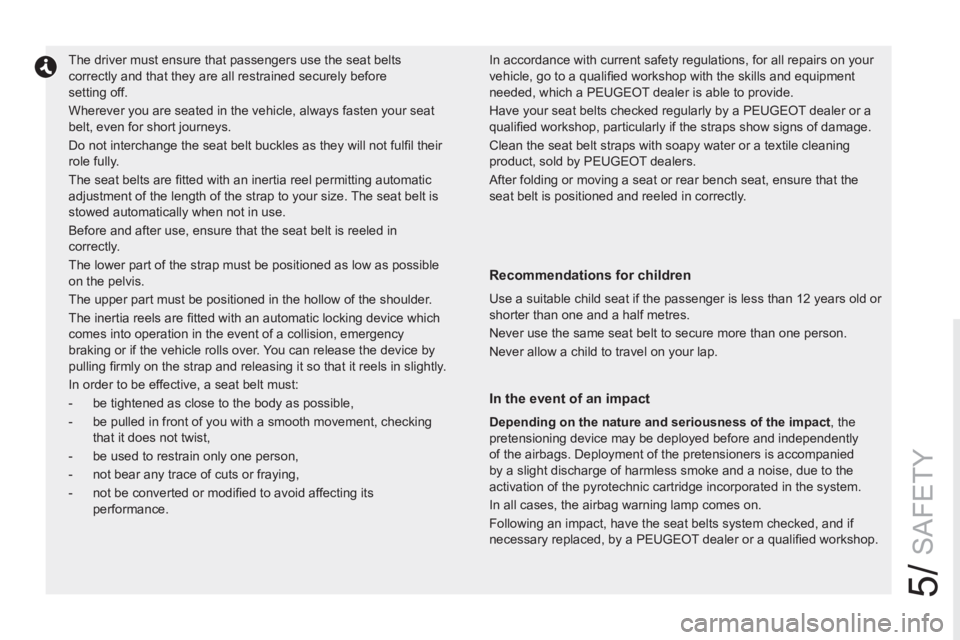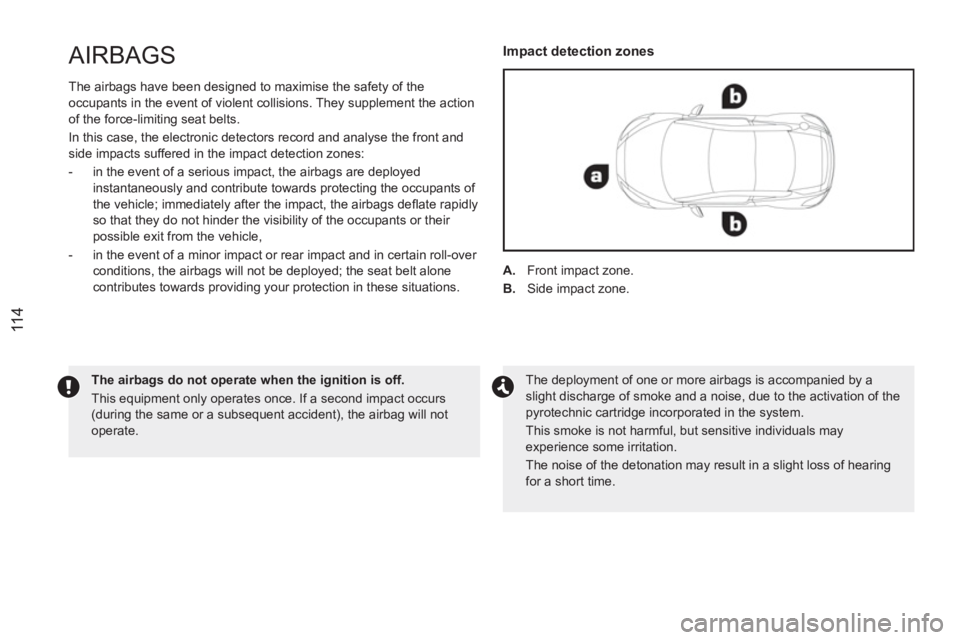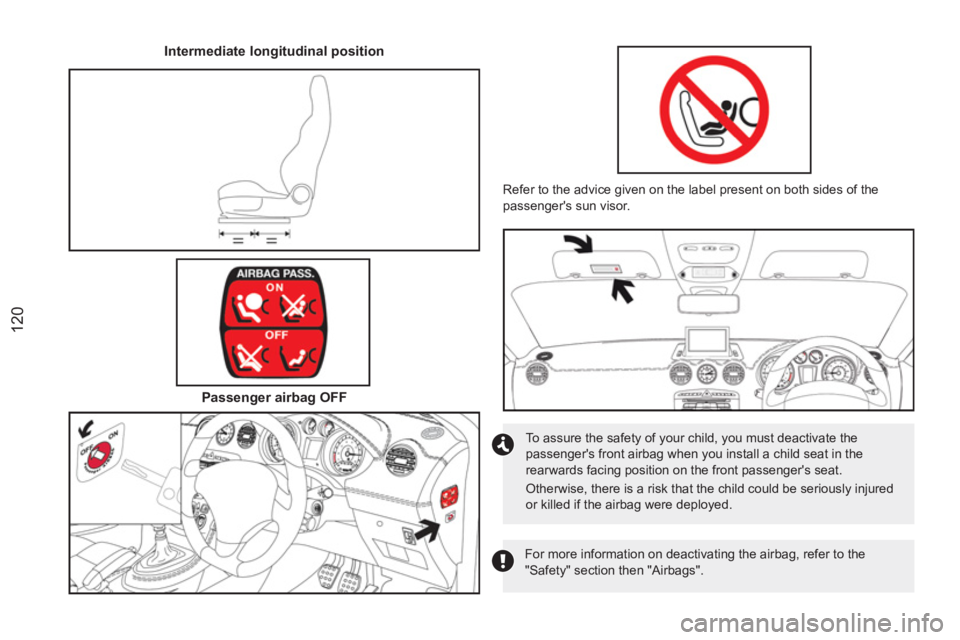2012 PEUGEOT RCZ airbag off
[x] Cancel search: airbag offPage 18 of 336

16
127
1.
Stop
position.
2.
Running
position.
3.
Starting
position.
IGNITION SWITCH
Avoid attaching any heavy objects to the
key which would weigh down on its shaft
in the ignition switch; this could cause a
malfunction.
PASSENGER SAFETY
�)
Selection of the position:
"OFF"
(deactivated), with "rear facing"
child seat,
"ON"
(activated), with front passenger or
"forwards facing" child seat.
PASSENGER'S FRONT AIRBAG
115, 119
A.
Front and/or rear seat belts not fastened /
unfastened warning lamp.
B.
Front left seat belt warning lamp.
C.
Front right seat belt warning lamp.
D.
Rear right seat belt warning lamp.
E.
Rear left seat belt warning lamp.
F.
Passenger's front airbag deactivated
warning lamp.
G.
Passenger's front airbag activated
warning lamp.
SEAT BELTS AND
PASSENGER'S FRONT AIRBAG
111, 115, 119
Page 33 of 336

1/
INSTRUMENTS and CONTROLS
Warning lamp
is on
Cause
Action / Observations
Rear foglamp
fi xed. The rear foglamp is switched on. Turn the ring on the stalk rearwards to switch off the rear
foglamp.
Diesel engine
pre-heating
fi xed. The ignition switch is at the
2nd position (ignition on). Wait until the warning lamp has switched off before starting.
The duration for which the warning lamp is on is
determined by the climatic conditions.
Parking
brake
fi xed. The parking brake is applied or
not properly released. Release the parking brake to switch off the warning lamp,
keeping your foot on the brake pedal.
Observe the safety recommendations.
For further information on the parking brake, refer to the
"Parking brake" section.
Passenger's
front airbag
fi xed on the
seat belt and
passenger's front
airbag warning
lamps display. The control switch, located on
the passenger's side of the
dashboard, has been placed in
the "ON"
position.
The passenger's front airbag is
activated.
In this case, do not install
a "rear facing" child seat. While you do not have a rear-facing child seat fi tted to
the front passenger seat, it is recommended that the
passenger's front airbag be activated.
On the other hand, before fi tting a rear-facing child seat,
you must turn the control switch to the "OFF"
position.
Page 34 of 336

32
Deactivation warning lamps
If one of the following warning lamps comes on, this confi rms that the
corresponding system has been switched off intentionally.
It is accompanied by an audible signal and a message on the screen.
Depending on your version of instrument panel, illumination of the
deactivation lamp is also accompanied by:
- a symbol in the central instrument panel screen and a message in
the multifunction screen,
or
- a symbol and a message in the central instrument panel screen.
Warning lamp
is on
Cause
Action / Observations
Passenger's
front airbag
fi xed, in the seat
belt and front
passenger's
airbag warning
lamps display. The control switch, located
on the passenger's end of
the dashboard, is set to the
OFF
position.
The passenger's front airbag is
deactivated.
You can install a "rear-facing"
child seat on the front seat. Before installing a "rear-facing" child seat on the front seat,
it is essential
to deactivate the passenger's front airbag.
On the other hand, where no "rear-facing" child seat is
present, it is recommended that the airbag be reactivated:
set the control to the ON
position.
ESC/ASR
fi xed. The button, located in the centre
of the dashboard, is pressed. Its
indicator lamp is on.
The following functions are
deactivated.
- electronic stability
programme (ESC),
- anti-slip regulation or traction
control (ASR),
- automatic operation of
hazard warning lamps. Press the button again to reactivate these functions
manually. Its indicator lamp goes off.
These functions are reactivated automatically when the
vehicle is started.
Page 57 of 336

2/
ACCESS
LOST KEYS
Visit a PEUGEOT dealer with the vehicle's registration document, your personal identifi cation documents and if possible the key code label.
The PEUGEOT dealer will be able to look up the key code and the transponder code required to order a new key.
LOCKING THE VEHICLE
Driving with the doors locked may make access to the passenger compartment by the emergency services more diffi cult in an emergency.
However, the vehicle unlocks automatically in the event of a serious impact causing airbag deployment.
As a safety precaution, never leave children alone in the vehicle, except for a very short period.
In all cases, it is essential to remove the key from the ignition switch when leaving the vehicle.
REMOTE CONTROL
The high frequency remote control is a sensitive system; do not operate it while it is in your pocket as there is a possibility that it may unlock
the vehicle, without you being aware of it.
Do not repeatedly press the buttons of your remote control out of range and out of sight of your vehicle. You run the risk of stopping it from
working and the remote control would have to be reinitialised.
No remote control can operate when the key is in the ignition switch, even when the ignition is switched off, except for reinitialisation.
ANTI-THEFT PROTECTION
Do not make any modifi cations to the electronic engine immobiliser system; this could cause malfunctions.
Do not throw the remote control batteries away, they contain metals which are harmful to the environment.
Take them to an approved collection point.
WHEN PURCHASING A SECOND-HAND VEHICLE
Have the pairing of all of the keys in your possession checked by a PEUGEOT dealer, to ensure that only your keys can be used to open and
start the vehicle.
Page 115 of 336

5/
SAFETY
The driver must ensure that passengers use the seat belts
correctly and that they are all restrained securely before
setting off.
Wherever you are seated in the vehicle, always fasten your seat
belt, even for short journeys.
Do not interchange the seat belt buckles as they will not fulfi l their
role fully.
The seat belts are fi tted with an inertia reel permitting automatic
adjustment of the length of the strap to your size. The seat belt is
stowed automatically when not in use.
Before and after use, ensure that the seat belt is reeled in
correctly.
The lower part of the strap must be positioned as low as possible
on the pelvis.
The upper part must be positioned in the hollow of the shoulder.
The inertia reels are fi tted with an automatic locking device which
comes into operation in the event of a collision, emergency
braking or if the vehicle rolls over. You can release the device by
pulling fi rmly on the strap and releasing it so that it reels in slightly.
In order to be effective, a seat belt must:
- be tightened as close to the body as possible,
- be pulled in front of you with a smooth movement, checking
that it does not twist,
- be used to restrain only one person,
- not bear any trace of cuts or fraying,
- not be converted or modifi ed to avoid affecting its
performance. In accordance with current safety regulations, for all repairs on your
vehicle, go to a qualifi ed workshop with the skills and equipment
needed, which a PEUGEOT dealer is able to provide.
Have your seat belts checked regularly by a PEUGEOT dealer or a
qualifi ed workshop, particularly if the straps show signs of damage.
Clean the seat belt straps with soapy water or a textile cleaning
product, sold by PEUGEOT dealers.
After folding or moving a seat or rear bench seat, ensure that the
seat belt is positioned and reeled in correctly.
Recommendations for children
Use a suitable child seat if the passenger is less than 12 years old or
shorter than one and a half metres.
Never use the same seat belt to secure more than one person.
Never allow a child to travel on your lap.
In the event of an impact
Depending on the nature and seriousness of the impact
, the
pretensioning device may be deployed before and independently
of the airbags. Deployment of the pretensioners is accompanied
by a slight discharge of harmless smoke and a noise, due to the
activation of the pyrotechnic cartridge incorporated in the system.
In all cases, the airbag warning lamp comes on.
Following an impact, have the seat belts system checked, and if
necessary replaced, by a PEUGEOT dealer or a qualifi ed workshop.
Page 116 of 336

11 4
AIRBAGS
The airbags have been designed to maximise the safety of the
occupants in the event of violent collisions. They supplement the action
of the force-limiting seat belts.
In this case, the electronic detectors record and analyse the front and
side impacts suffered in the impact detection zones:
- in the event of a serious impact, the airbags are deployed
instantaneously and contribute towards protecting the occupants of
the vehicle; immediately after the impact, the airbags defl ate rapidly
so that they do not hinder the visibility of the occupants or their
possible exit from the vehicle,
- in the event of a minor impact or rear impact and in certain roll-over
conditions, the airbags will not be deployed; the seat belt alone
contributes towards providing your protection in these situations.
The airbags do not operate when the ignition is off.
This equipment only operates once. If a second impact occurs
(during the same or a subsequent accident), the airbag will not
operate. The deployment of one or more airbags is accompanied by a
slight discharge of smoke and a noise, due to the activation of the
pyrotechnic cartridge incorporated in the system.
This smoke is not harmful, but sensitive individuals may
experience some irritation.
The noise of the detonation may result in a slight loss of hearing
for a short time.
A.
Front impact zone.
B.
Side impact zone.
Impact detection zones
Page 117 of 336

5/
SAFETY
FRONT AIRBAGS
System which protects the driver and front passenger in the event of
a serious front impact in order to limit the risk of injury to the head and
thorax.
The driver's airbag is fi tted in the centre of the steering wheel; the front
passenger's airbag is fi tted in the dashboard above the glove box.
Deployment
The airbags are deployed, except the passenger's front airbag if it is
deactivated, in the event of a serious front impact to all or part of the
front impact zone A
, in the longitudinal centreline of the vehicle on a
horizontal plane and directed from the front to the rear of the vehicle.
The front airbag infl ates between the thorax and head of the front
occupant of the vehicle and the steering wheel, driver's side, and the
dashboard, passenger's side to cushion their forward movement.
Deactivation
Only the passenger's front airbag can be deactivated:
�)
with the ignition off
, insert the key in the passenger airbag
deactivation switch,
�)
turn it to the "OFF"
position,
�)
then, remove the key keeping the switch in the new position.
To assure the safety of your child, the passenger's front airbag
must be deactivated when you install a "rear facing" child seat on
the front passenger seat.
Otherwise, the child would risk being seriously injured or killed if
the airbag were deployed. This warning lamp comes on in the passenger's front airbag
warning lamps display when the ignition is on and until the
airbag is reactivated.
Page 122 of 336

120
Intermediate longitudinal position
Passenger airbag OFF
For more information on deactivating the airbag, refer to the
"Safety" section then "Airbags".
Refer to the advice given on the label present on both sides of the
passenger's sun visor.
To assure the safety of your child, you must deactivate the
passenger's front airbag when you install a child seat in the
rearwards facing position on the front passenger's seat.
Otherwise, there is a risk that the child could be seriously injured
or killed if the airbag were deployed.